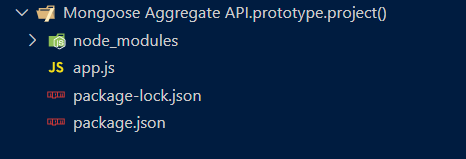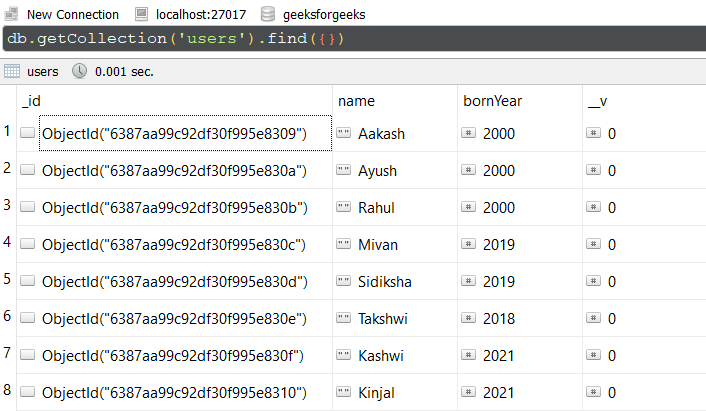Mongoose API 的 Aggregate API.prototype.project() 方法用於執行聚合任務。它允許我們從集合中選擇字段。使用此方法,我們可以請求將選定的字段從集合中提取到結果集中。如果您不希望集合中的所有字段都包含在結果集中,可以使用project()請求將指定字段包含在結果集中。總的來說,我們可以為結果集指定包含字段和排除字段。
句法:
aggregate().project( specifications )
參數:此方法接受單個參數,如下所述:
- Object/String: 它用於指定要在結果集中包含和排除的字段。
返回值:該方法以數組的形式返回結果集。
設置 Node.js Mongoose 模塊:
步驟 1:使用以下命令創建 Node.js 應用程序:
npm init
步驟 2:創建 NodeJS 應用程序後,使用以下命令安裝所需的模塊:
npm install mongoose
項目結構: 項目結構將如下所示:

數據庫結構:數據庫結構如下所示,集合中存在以下文檔。

示例 1:在此示例中,我們使用 mongoose 建立了數據庫連接,並通過 userSchema 定義了模型,具有三個列或字段 “_id”、“name” 和 “bornYear”。最後,我們呼籲project()方法通過以對象的形式傳遞規範。在這個例子中,我們想要_id和名字包含在結果集中。這就是為什麽我們將它們的值設置為1。如果您不希望任何字段包含在結果集中,則可以不在規範中提及它,也可以指定0 作為該字段的值。
文件名:app.js
Javascript
// Require mongoose module
const mongoose = require("mongoose");
// Set Up the Database connection
mongoose.connect("mongodb://localhost:27017/geeksforgeeks", {
useNewUrlParser: true,
useUnifiedTopology: true,
});
const userSchema = new mongoose.Schema({
name: String,
bornYear: Number
});
const User = mongoose.model('User', userSchema);
User.aggregate()
.project({ _id: 1, name: 1 })
.then((result, error) => {
if (result)
console.log(result);
else
console.log(error)
})運行程序的步驟:要運行應用程序,請從項目的根目錄執行以下命令:
node app.js
輸出:
[
{ _id: new ObjectId("6387aa99c92df30f995e8309"), name: 'Aakash' },
{ _id: new ObjectId("6387aa99c92df30f995e830a"), name: 'Ayush' },
{ _id: new ObjectId("6387aa99c92df30f995e830b"), name: 'Rahul' },
{ _id: new ObjectId("6387aa99c92df30f995e830c"), name: 'Mivan' },
{ _id: new ObjectId("6387aa99c92df30f995e830d"), name: 'Sidiksha' },
{ _id: new ObjectId("6387aa99c92df30f995e830e"), name: 'Takshwi' },
{ _id: new ObjectId("6387aa99c92df30f995e830f"), name: 'Kashwi' },
{ _id: new ObjectId("6387aa99c92df30f995e8310"), name: 'Kinjal' }
]
示例 2:在此示例中,我們使用 mongoose 建立了數據庫連接,並通過 userSchema 定義了模型,具有三列或字段 “_id”、“name” 和 “bornYear”,我們調用aggregate()用戶模型上的方法。在這個例子中,我們隻想要出生年份要包含在結果集中的字段。這就是為什麽我們分配了1 到出生年份場和0 到_ID。我們沒有提到過名字字段,因此它將自動被視為不包含在結果集中。
文件名:app.js
Javascript
// Require mongoose module
const mongoose = require("mongoose");
// Set Up the Database connection
mongoose.connect("mongodb://localhost:27017/geeksforgeeks", {
useNewUrlParser: true,
useUnifiedTopology: true,
});
const userSchema = new mongoose.Schema({
name: String,
bornYear: Number
});
const User = mongoose.model('User', userSchema);
User.aggregate([{ $project: { _id: 0, bornYear: 1 } }])
.exec((error, result) => {
if (error) {
console.log(error);
} else {
console.log(result);
}
})運行程序的步驟:要運行應用程序,請從項目的根目錄執行以下命令:
node app.js
輸出:
[
{ bornYear: 2000 },
{ bornYear: 2000 },
{ bornYear: 2000 },
{ bornYear: 2019 },
{ bornYear: 2019 },
{ bornYear: 2018 },
{ bornYear: 2021 },
{ bornYear: 2021 }
]
參考:https://mongoosejs.com/docs/api/aggregate.html#aggregate_Aggregate-project
相關用法
- Mongoose Aggregate.prototype.pipeline()用法及代碼示例
- Mongoose Aggregate.prototype.catch()用法及代碼示例
- Mongoose Aggregate.prototype.exec()用法及代碼示例
- Mongoose Aggregate.prototype.model()用法及代碼示例
- Mongoose Aggregate.prototype.skip()用法及代碼示例
- Mongoose Aggregate.prototype.limit()用法及代碼示例
- Mongoose Aggregate.prototype.then()用法及代碼示例
- Mongoose Aggregate.prototype.append()用法及代碼示例
- Mongoose Aggregate.prototype.sortByCount()用法及代碼示例
- Mongoose Aggregate.prototype.match()用法及代碼示例
- Mongoose Aggregate.prototype.cursor()用法及代碼示例
- Mongoose Aggregate.prototype.sort()用法及代碼示例
- Mongoose Aggregate.prototype.addFields()用法及代碼示例
- Mongoose Aggregate.prototype.lookup()用法及代碼示例
- Mongoose Aggregate prototype.unionWith()用法及代碼示例
- Mongoose Aggregate prototype.sample()用法及代碼示例
- Mongoose Aggregate prototype.unwind()用法及代碼示例
- Mongoose countDocuments()用法及代碼示例
- Mongoose deleteMany()用法及代碼示例
- Mongoose deleteOne()用法及代碼示例
- Mongoose estimatedDocumentCount()用法及代碼示例
- Mongoose exists()用法及代碼示例
- Mongoose find()用法及代碼示例
- Mongoose findById()用法及代碼示例
- Mongoose findByIdAndDelete()用法及代碼示例
注:本文由純淨天空篩選整理自sakshio0hoj大神的英文原創作品 Mongoose Aggregate.prototype.project() API。非經特殊聲明,原始代碼版權歸原作者所有,本譯文未經允許或授權,請勿轉載或複製。
